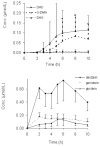Bioavailability of phytochemical constituents from a novel soy fortified lycopene rich tomato juice developed for targeted cancer prevention trials
- PMID: 22098224
- PMCID: PMC3850031
- DOI: 10.1080/01635581.2011.630156
Bioavailability of phytochemical constituents from a novel soy fortified lycopene rich tomato juice developed for targeted cancer prevention trials
Abstract
Studies suggest that tomato and soy foods may contribute to a lower risk of certain cancers. We developed a novel soy germ tomato juice to be used in controlled cancer prevention trials. This study describes an initial test of compliance, phytochemical bioavailability, and effects on biomarkers of blood lipids. Healthy men and women (n = 18) consumed a soy germ-fortified juice daily (300 mL supplying 66 mg isoflavones and 22 mg lycopene) for 8 wk. A single-dose bioavailability study was completed on day 1 and isoflavones in plasma and urine, and lycopene in the plasma, were measured. All subjects completed the trial, with 97.7% ± 3.5% (mean ± SD) of the scheduled juice consumed. No adverse effects were documented. The postprandial study indicated that 3.1% ± 2.3% of lycopene was absorbed and that 49.3% ± 12.1% isoflavones ingested were recovered in 24-h urines. Lycopene plasma concentration changed from 0.60 ± 0.22 to 1.24 ± 0.30 μmol/L during 8 wk of consumption. Juice consumption significantly improved resistance of LDL+VLDL-C to Cu(2+)-mediated oxidation (P = 0.039), HDL-C (47.3 ± 15.8 to 51.7 ± 14.8 mg/dL, P < 0.001), and the ratio of total-C/HDL-C (4.25 ± 1.59 to 3.63 ± 1.16, P < 0.001) at 8 wk. A well-characterized soy-fortified tomato juice can be produced in large scale for multiinstitutional long-term cancer prevention trials and showed excellent compliance with no toxicity, while demonstrating absorption of biologically active phytochemicals.
Figures


Similar articles
-
Lycopene from heat-induced cis-isomer-rich tomato sauce is more bioavailable than from all-trans-rich tomato sauce in human subjects.Br J Nutr. 2007 Jul;98(1):140-6. doi: 10.1017/S0007114507685201. Epub 2007 Mar 29. Br J Nutr. 2007. PMID: 17391568 Clinical Trial.
-
Chronic ingestion of lycopene-rich tomato juice or lycopene supplements significantly increases plasma concentrations of lycopene and related tomato carotenoids in humans.Am J Clin Nutr. 1998 Dec;68(6):1187-95. doi: 10.1093/ajcn/68.6.1187. Am J Clin Nutr. 1998. PMID: 9846845 Clinical Trial.
-
Carotenoids in human buccal mucosa cells after 4 wk of supplementation with tomato juice or lycopene supplements.Am J Clin Nutr. 1999 Oct;70(4):490-4. doi: 10.1093/ajcn/70.4.490. Am J Clin Nutr. 1999. PMID: 10500017 Clinical Trial.
-
Role of tomatoes, tomato products and lycopene in cancer prevention.Adv Exp Med Biol. 2001;492:29-37. doi: 10.1007/978-1-4615-1283-7_4. Adv Exp Med Biol. 2001. PMID: 11480673 Review. No abstract available.
-
Tomatoes versus lycopene in oxidative stress and carcinogenesis: conclusions from clinical trials.Eur J Clin Nutr. 2007 Mar;61(3):295-303. doi: 10.1038/sj.ejcn.1602510. Epub 2006 Aug 16. Eur J Clin Nutr. 2007. PMID: 16929242 Review.
Cited by
-
Oxidative Stress: The Role of Antioxidant Phytochemicals in the Prevention and Treatment of Diseases.Int J Mol Sci. 2024 Mar 13;25(6):3264. doi: 10.3390/ijms25063264. Int J Mol Sci. 2024. PMID: 38542238 Free PMC article. Review.
-
Plant Polyphenols and Their Potential Benefits on Cardiovascular Health: A Review.Molecules. 2023 Sep 1;28(17):6403. doi: 10.3390/molecules28176403. Molecules. 2023. PMID: 37687232 Free PMC article. Review.
-
Carotenoids in Health as Studied by Omics-Related Endpoints.Adv Nutr. 2023 Nov;14(6):1538-1578. doi: 10.1016/j.advnut.2023.09.002. Epub 2023 Sep 9. Adv Nutr. 2023. PMID: 37678712 Free PMC article. Review.
-
Tomatoes, Lycopene, and Prostate Cancer: What Have We Learned from Experimental Models?J Nutr. 2022 Jun 9;152(6):1381-1403. doi: 10.1093/jn/nxac066. J Nutr. 2022. PMID: 35278075 Free PMC article. Review.
-
Whey- and Soy Protein Isolates Added to a Carrot-Tomato Juice Alter Carotenoid Bioavailability in Healthy Adults.Antioxidants (Basel). 2021 Oct 31;10(11):1748. doi: 10.3390/antiox10111748. Antioxidants (Basel). 2021. PMID: 34829619 Free PMC article.
References
-
- Willcox JK, Catignani GL, Lazarus S. Tomatoes and cardiovascular health. Crit Rev Food Sci Nutr. 2003;43:1–18. - PubMed
-
- Palozza P, Parrone N, Catalano A, Simone R. Tomato lycopene and inflammatory cascade: basic interactions and clinical implications. Curr Med Chem. 2010;17:2547–2563. - PubMed
-
- Clinton SK. Tomatoes or lycopene: a role in prostate carcinogenesis? J Nutr. 2005;135:2057S–2059S. - PubMed
-
- Giovannucci E. Tomato products, lycopene, and prostate cancer: a review of the epidemiological literature. J Nutr. 2005;135:2030S–2031S. - PubMed
-
- Fleshner N, Zlotta AR. Prostate cancer prevention: past, present, and future. Cancer. 2007;110:1889–1899. - PubMed
Publication types
MeSH terms
Substances
Grants and funding
LinkOut - more resources
Full Text Sources

